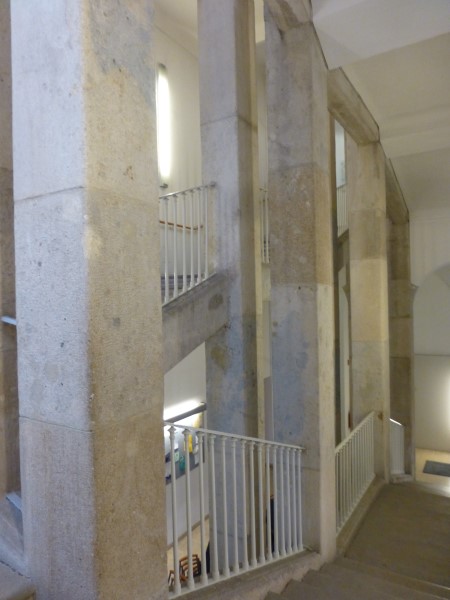Housing Conservatory in Gustav Mahlers days
- Vienna I, Giselastrasse 12 (now Bosendorferstrasse 12, Gesellschaft der Musikfreunde, Musikverein)
- Konservatorium der Gesellschaft der Musikfreunde in Vienna (1812-1909)
- Since 1817 called Gesellschaft der Musikfreunde (privat institution)
- Since 06-01-1870 the conservatory was housed on the second floor, in the right wing, of the Gesellschaft der Musikfreunde (Musikverein).
- Gesellschaft der Musikfreunde (Musikverein).
- The small hall is now known as the “Brahms Saal”.
Housing Conservatory later
- In 1909 ordered by Franz Josef I, Emperor (1830-1916) under state supervision and renamed „k.k. Akademie für Musik und darstellende Kunst“.
- Universität für Musik und Darstellende Kunst Wien (abbreviated MDW).
- Anton von Webern Platz No. 1.
Directors/Rectors
- 1851-1893 Joseph Hellmesberger Sr. (1828-1893).
- 1893-1899 Johann Nepomuk Fuchs (1842-1899).
- 1899-1907 Richard von Perger (1854-1911).
Years of education and Gustav Mahlers concerts
- Year 1875. 10-09-1875. Commencement.
- Year 1876. 1876 Concert Vienna 23-06-1876 (piano). Small hall (598 seats). Brahms Saal.
- Year 1877. 1877 Concert Vienna 21-06-1877 (piano). Small hall (598 seats). Brahms Saal.
- Year 1877. 1877 Concert Vienna 20-10-1877 (piano). Small hall (598 seats). Brahms Saal.
- Year 1878. 1878 Concert Vienna 11-07-1878 – Piano quintet (Premiere, piano). Graduation: Piano and Composition. Great hall (2,063 seats). Golden Hall.
Teachers
- 1875-1876 Piano: Julius Epstein (1832-1926).
- 1877-1878 Harmony: Robert Fuchs (1847-1927).
- 1877-1878 Contrapunt and composition: Franz Krenn (1816-1897).
- Musik history: Adolf Prosnitz.
- No conducting class those days.
Fellow students (sorted by age)
- Hans Rott (1858-1884)
- Anton Krisper (1858-1914)
- Rudolf Krzyzanowski (1859-1911)
- Hugo Wolf (1860-1903). Friend of Gustav Mahler. He had to leave the Conservatory because of discipline issues. Mahler was saved by a letter to Joseph Hellmesberger Sr. (1828-1893)
- Arnold Josef Rose (1863-1946).
Remarks
- Few compositions by Gustav Mahler have survived from this period.
- Mahler played percussion in the Student Orchestra.
- He attended occasional lectures by Anton Bruckner (1824-1896). Bruckner was not one of Mahlers teachers.
- 16-12-1877 he was at a catastrophic performance of Bruckners Symphony No. 3.
- Along with many music students of his generation Gustav Mahler fell under the spell of Richard Wagner (1813-1883), although his main interest was the sound of the music instead of the staging. It is not known whether he saw one of Wagner’s operas during his student days.
- Gustav Mahler continues his studies at the University of Vienna (Dr-Karl-Lueger-Ring).
Former students (in order of age)
- Karl Goldmark (1830-1915).
- Hans Richter (1843-1916).
- Arthur Nikisch (1855-1922).
- Felix Mottl (1856-1911).
- Natalie Bauer-Lechner (1858-1921). Period 1866-1872.
- Gustav Mahler (1860-1911). Period 1875-1878.
- Hugo Wolf (1860-1903).
- Jean Sibelius (1865-1957).
- Fritz Kreisler (1875-1962).
- Bruno Walter (1876-1962).
- Grete Wiesenthal (1885-1970).
- Ernst Krenek (1900-1991).
- Mariss Jansons (1943).
History of the Conservatory of Vienna
Calls for a music conservatory in Vienna started in 1808. In 1811 an “outline for a music education institution” for Vienna was published. A year later the Society for the Friends of Music was formed, with the foremost aim of establishing a conservatory. The Vienna Conservatory was founded in 1817. It was meant to be modeled on the Paris Conservatory, but, due to a lack of funds, it began solely as a singing school. Antonio Salieri was the Conservatory’s first director. In 1819, it hired violinist Joseph Böhm, and by 1827 offered courses in most orchestral instruments.
The conservatory’s finances were very unstable. Tuition fees were introduced in 1829, but by 1837 the institution was bankrupt. The state eventually funded the conservatory from 1841 to 1844 and from 1846 to 1848. In 1848 political unrest caused the state to discontinue funding, and the Conservatory did not offer courses again until 1851. With support from the state and the city, finances again stabilized after 1851.
Despite growing state subsidy, The Society for the Friends of Music, which founded the Conservatory, remained in control of the institution. However, by a 01-01-1909 imperial resolution the school was nationalized and became the Imperial Academy of Music and the Performing Arts (k.k. Akademie für Musik und darstellende Kunst). Until then its name was the Konservatorium der Gesellschaft der Musikfreunde (Musikverein).
Until 1844, when Gottfried Preyer, professor of harmony and composition became director, the director of the conservatory was not a member of faculty, but a member of the Society for the Friends of Music. Joseph Hellmesberger Sr. (1828-1893) was director from 1851 to 1893.
From 1907 Wilhelm Bopp had been the director of Conservatory. The Conservatory was still dominated by the aging Robert Fuchs (1847-1927) and Hermann Grädener, both of whom, but especially Fuchs, Bopp considered to be anachronistic and out of touch.
In 1912, attempting to rejuvenate the conservatory Bopp offered teaching positions to Franz Schreker (1878-1934) and Arnold Schoenberg (1874-1951). Schoenberg declined the offer, but Schreker accepted it. His teaching duties were carried through with great success and by January 1913 he was awarded a full professorship.
Bopp was also instrumental in the 1909 nationalization of the Conservatory. The administration of the Academy was now assigned to a state-appointed president, an artistic director and a board of trustees.






